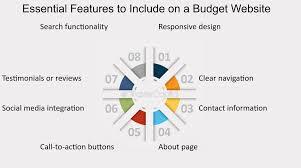Creating a professional-looking website on a budget can seem like a daunting task, but with the right approach, you can craft a site that not only looks great but also functions efficiently. Whether you're a small business owner, freelancer, or someone just looking to create an online presence, you don't have to spend a fortune to build a high-quality website. This guide provides expert advice on how to Create Budget website that still maintains a professional edge.
- Start with a Clear Objective
Before diving into design or development, it’s crucial to have a clear understanding of the purpose of your website. Is it for e-commerce, showcasing a portfolio, blogging, or offering services? Knowing your primary goal will help you make strategic decisions about the structure, design, and features you need, thereby avoiding unnecessary expenses.
Key Questions to Ask:
What is the primary goal of my website?
Who is my target audience?
What functionalities do I need?
By answering these questions, you’ll create a roadmap, preventing scope creep, and ensuring that every dollar spent serves a purpose.
- Choose the Right Website Builder or CMS
When creating a budget website, selecting the right platform is critical. For most small to medium projects, there are affordable website builders and content management systems (CMS) that offer professional templates and easy-to-use interfaces without needing extensive coding knowledge.
Popular Options:
WordPress: One of the most flexible and popular CMS platforms, especially for blogs, business sites, and portfolios. WordPress offers both free and paid themes and plugins, making it adaptable to a range of budgets.
Wix: Ideal for beginners, Wix offers drag-and-drop functionality and a variety of templates, making it easy to design a professional-looking website without coding.
Squarespace: Known for its sleek, modern templates, Squarespace is great for creatives and professionals wanting a polished look. It comes with built-in tools like SEO optimization and e-commerce functionalities.
Weebly: Similar to Wix, Weebly offers simple drag-and-drop editing and is particularly budget-friendly for smaller websites.
Many of these platforms offer free versions or low-cost monthly plans that can save you money in the initial stages.
- Select an Affordable Domain and Hosting Service
A custom domain (like yourbusiness.com) and reliable hosting are essential for a professional website. While most website builders offer domain and hosting bundles, you can often find better deals by purchasing them separately.
Domain Name Tips:
Aim for a .com extension if possible, as it’s the most recognizable and trusted.
Use domain name generators if your ideal domain is taken.
For hosting, consider:
Bluehost: Popular for WordPress websites, Bluehost offers affordable plans, a free domain for the first year, and excellent customer support.
HostGator: Another cost-effective option, HostGator provides cheap hosting with scalable plans, making it great for growth.
SiteGround: Known for its excellent performance and security, SiteGround may be slightly pricier, but the quality of service can justify the cost in the long run.
Some budget-friendly hosts offer shared hosting plans, meaning multiple websites are hosted on the same server, keeping costs low.
- Leverage Free or Low-Cost Themes and Templates
While custom designs can be expensive, there are numerous high-quality, free, or low-cost themes and templates available. Many website builders, such as WordPress, Wix, and Squarespace, offer templates that are designed by professionals, allowing you to give your website a sleek look with minimal investment.
Considerations When Choosing a Theme:
Responsiveness: Ensure that your website looks good on both desktop and mobile devices.
Customization Options: Choose a theme that allows some degree of customization so that you can adjust the design to suit your brand.
Speed and Performance: A well-coded theme will load quickly, improving user experience and SEO rankings.
If you have a bit more in your budget, you can buy premium themes from marketplaces like ThemeForest or Elegant Themes, which often provide better customization options and long-term support.
- Optimize Your Website for User Experience
A professional website isn't just about looking good—it also needs to function smoothly. Prioritize user experience (UX) by ensuring that your site is easy to navigate, fast, and accessible.
Best Practices for UX:
Clean Navigation: Stick to simple, intuitive menus. Avoid overloading your visitors with too many options.
Fast Load Times: Optimize images, use caching plugins, and choose a lightweight theme to improve page loading speeds.
Mobile Optimization: With the majority of users browsing on mobile, ensure your site is mobile-friendly by using a responsive design.
Clear Calls to Action (CTA): Encourage visitors to take action, such as "Buy Now," "Sign Up," or "Learn More," using prominent, well-placed buttons.
- Use Free or Affordable Tools for Graphics and Branding
High-quality images, icons, and branding elements are critical for a professional website, but that doesn’t mean you need to hire a designer or photographer right away. There are many free or affordable tools available to create or source visual elements.
Tools and Resources:
Canva: A powerful design tool that allows you to create professional-looking graphics and logos with a drag-and-drop interface. Canva has a free plan with plenty of features.
Unsplash and Pexels: These sites offer free, high-quality images that you can use for your website.
Google Fonts: Choose from a wide variety of free fonts to ensure your typography is professional and consistent.
Figma: A collaborative design tool, Figma allows you to create and prototype web designs. It’s free for individual users and small teams.
Conclusion
Building a professional-looking website on a budget is entirely achievable with the right strategy and tools. By choosing an affordable platform, leveraging free resources, optimizing for performance, and focusing on content, you can create a site that looks polished without breaking the bank. Remember, a well-designed website is an investment in your brand, so even when working with limited funds, the steps you take today can pay off in the long run.
